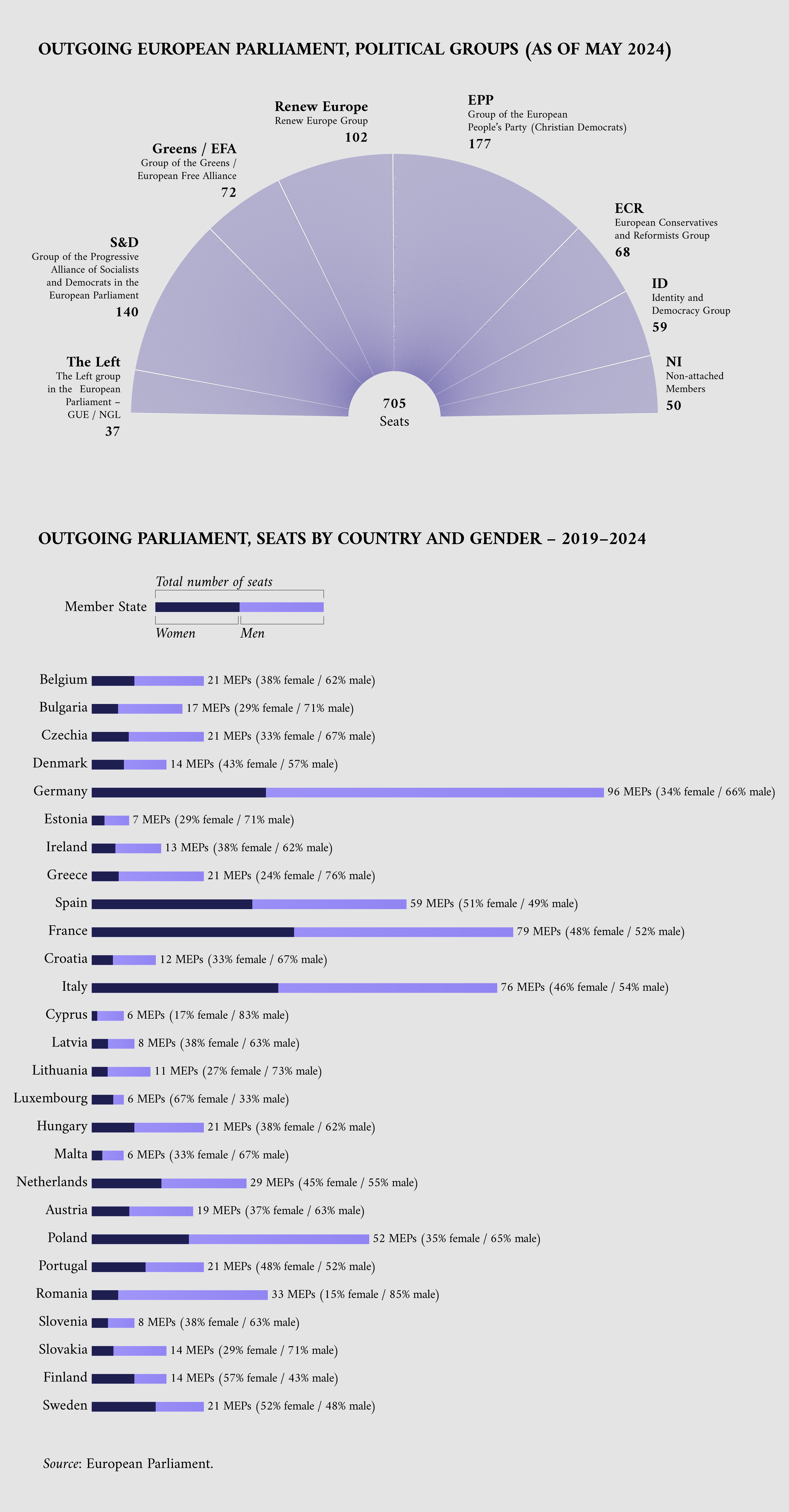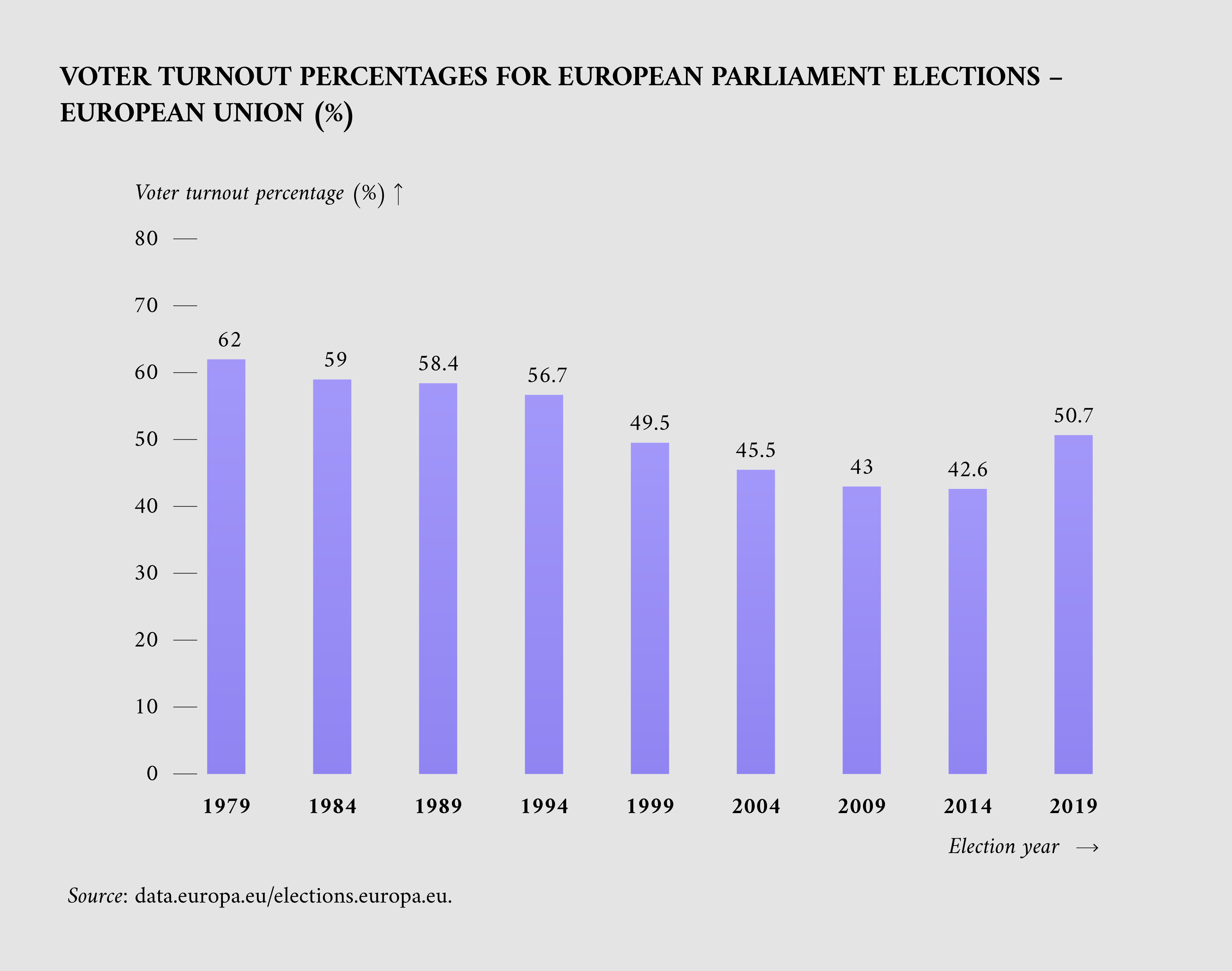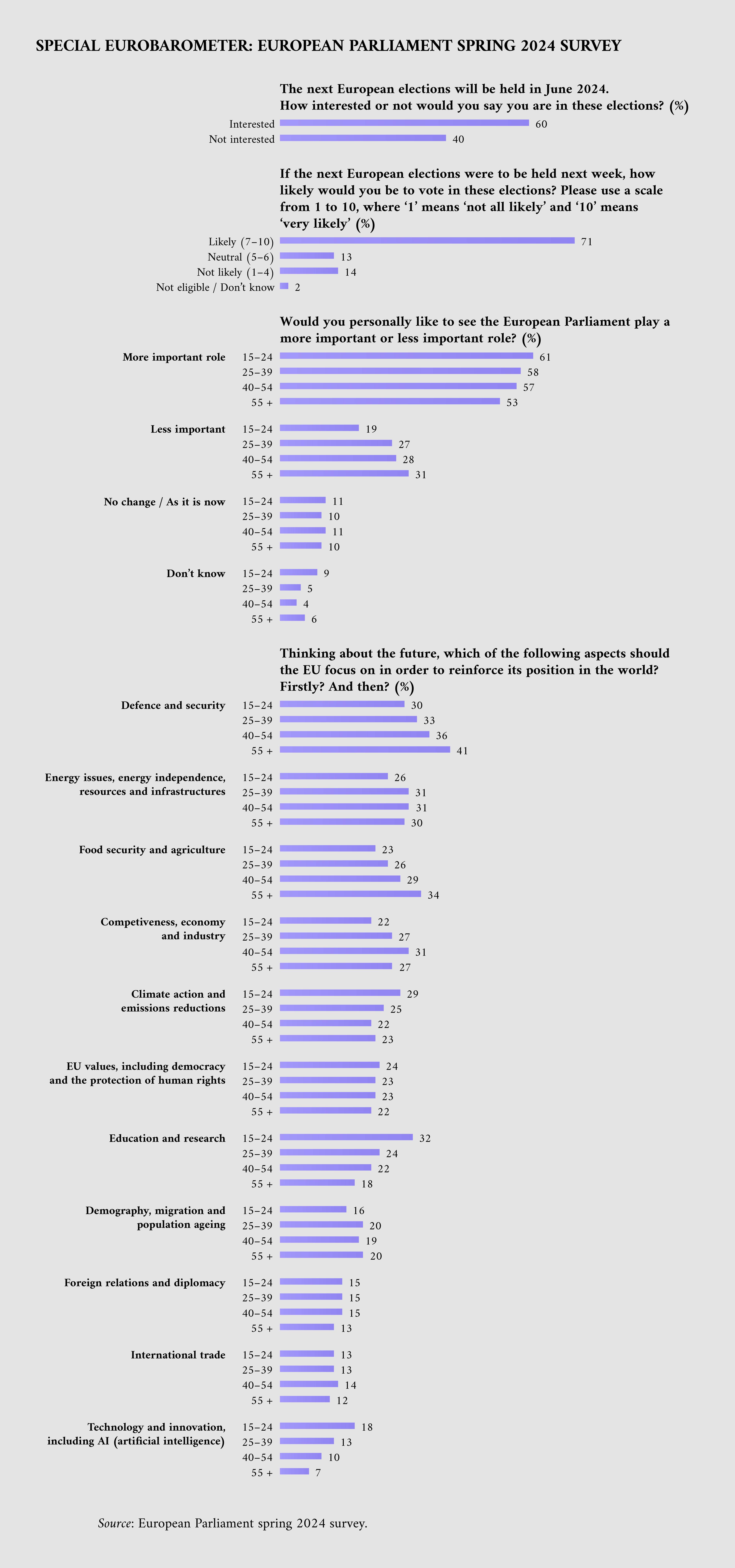Preparing for the 2024 European Parliament elections with open data
A broad overview of the EU elections: The outgoing European Parliament and key facts about past European Parliament elections
In the European Parliament elections, citizens have the opportunity to choose their direct representatives at EU level in the European Parliament. Comprising Members of the European Parliament (MEPs) elected in each EU Member State, the European Parliament is the world’s only directly elected transnational assembly. The number of MEPs per Member State follows a degressive proportionality model based on population size, with a minimum of six MEPs for smaller Member States and a maximum of ninety-six for larger ones. While candidates present themselves in national parties, elected MEPs often align with pan-European political parties.
As an institution, the European Parliament, along with the Council of the European Union, decides on laws proposed by the European Commission, amending them where appropriate. Additionally, the Parliament has the authority to elect the President of the Commission, approve or reject the Commission as a whole and, together with the Council of the European Union, decide on the EU budget, based on a proposal from the Commission.
EU elections occur every 5 years. The latest were in May 2019, with the forthcoming scheduled for 6–9 June 2024. Featuring over 400 million eligible voters, these elections represent the second largest democratic exercise worldwide. The integrity of free and fair elections hinges on the ability of voters to make choices without manipulation. The EU implements rigorous measures to combat disinformation, cyberattacks and data breaches. In a previous data story, we explored how open data plays a crucial role in countering cyber disinformation.
In today’s data-driven exploration, we aim to deliver an analysis of the European Parliament elections through the lens of open data. This narrative serves three primary objectives: firstly, to present the structure of the most recent legislature, detailing its composition and the mechanisms of representation within the European Parliament; secondly, to review voter engagement over time; and lastly, to provide insights into the pivotal factors that are shaping the upcoming 2024 elections. Through data analysis, we seek to equip readers with a deeper understanding of the electoral process and the critical issues at stake, thereby fostering a more informed and engaged electorate.
Understanding the parliamentary structure through open data
The majority of MEPs, elected on a national basis, affiliate themselves with European political groups that align with their ideological and political stances. Each political group must have a minimum of 23 MEPs from at least one quarter of the Member States. Some MEPs choose not to affiliate with any political group and are referred to as non-attached members.
The total number of MEPs for each parliamentary term is set before each EU election, with a cap set at 750 plus the president. The upcoming 2024 elections will see 720 MEPs elected, a rise of 15 from previous elections. Let’s use open data to analyse the current composition of the Parliament. Figure 1 offers an overview of the outgoing Parliament as of April 2024. It delineates the seven political groups within the Parliament and illustrates the distribution of the total 705 seats among the parties (and non-attached MEPs). As we can see, the three largest groups are the European People’s Party, which counts 177 MEPs, the Socialists and Democrats, with 140 MEPs, and Renew Europe with 102 elected representatives.
Germany, with a population exceeding 80 million, has elected 96 MEPs, followed by France with approximately 68 million inhabitants and 79 MEPs, and Italy with a population of 59 million and 76 MEPs. Interestingly, Figure 1 also indicates the gender distribution among MEPs per Member State. We see a balanced division between female and male MEPs in several countries, such as Denmark, Spain, France, Italy, the Netherlands, and Sweden. Luxembourg and Finland are the two countries with the highest percentage of female MEPs, respectively 67 % and 57 %. You can continue to explore the interactive dashboard here.

Figure 1: The composition of the outgoing European Parliament as of April 2024, with a focus on the political party affiliation and gender division of the MEPs (Source: results.elections.europa.eu)
Using open data to understand the history of EU elections
The European Parliament traces its roots back to the Common Assembly of the European Coal and Steel Community. Since 1979, its members have been directly elected, transforming it from an assembly of appointed members to a parliament chosen by the citizens of the EU. Initially, in the 1979–1984 term, the Parliament had 434 seats. The major parties at the time included the Socialist Group with 124 MEPs and the Group of the European People's Party with 117 MEPs. As the number of Member States increased, so did the seats in the Parliament. However, in 2020, there was a decrease in MEPs due to the United Kingdom’s withdrawal from the EU, reducing the number from 751 to 705. Of the United Kingdom’s 73 seats, 27 were redistributed to other countries, while 46 were reserved for future enlargements.
Changes have not only occurred on the legislative side but also in voter behaviour. Turnout rates vary widely between Member States and have the power to significantly impact election outcomes. Figure 2 shows the voter turnout over the years. The highest turnout was registered in the first European Parliament election, where more than 60% of the population voted. Although there was a slight progressive decrease in subsequent years, 2019 saw a resurgence with around 51% voter participation. Analyses identified several key factors contributing to this resurgence, most notably an increased awareness of the EU’s impact on daily life and a stronger belief among citizens that their votes truly matter in shaping EU policies. This renewed interest was also spurred by heightened concerns about key issues such as climate change, political stability and economic policies within the EU. Open data facilitates analysis of this important trend.
Shortly after the next EU elections in June, you will be able to explore how the turnout trend has evolved but also see the results and updated Parliament composition on the 2024 European election results website.

Figure 2: Voter turnout from the first legislature in 1979 up until 2019 (Source: data.europa.eu, elections.europa.eu)
Using open data to understand the current elections
Open data not only provides insights into the past but is also essential for forecasting the future. Just recently, the European Parliament released the spring 2024 survey following the public trends ahead of the upcoming elections. The survey sheds light on Europeans’ voting behaviour, their attitudes towards campaign topics and their preferences for the priority values for the next term of the European Parliament. It also focuses on citizens’ perception of the European Parliament and the EU and on their perspective on life in the EU, along with their opinions about the EU within the current global context.
Interest in the election, awareness of when it will take place and the likelihood of voting are all on the rise since the previous survey in autumn 2023. Increases are even more striking in comparison to the spring 2019 survey (3 months prior to the previous EU elections). Findings also suggest that EU citizens are very much aware of the importance of the elections in the current geopolitical context. Figure 3 presents key findings. Most of the respondents (60 %) are interested in the upcoming elections, and 71% affirm that they would vote if the EU elections were to be held the upcoming week. These findings suggest that EU citizens are clearly aware of the significance of this political moment.
The demographic analysis of the results reveals intriguing patterns. Young individuals between 15 and 24 years old display a very favourable stance towards the European Parliament’s activities, with over 60% supporting a more significant role for the Parliament. Across the board, this inclination is evident among all age groups, with the desire for the European Parliament to assume a more pivotal role staying elevated, consistently above 50% among all age groups.
When asked about the top priority for the EU, citizens place ‘defence and security’ (37%) as the first priority in reinforcing the EU’s position globally, followed by ‘energy issues’ and ‘food security / agriculture’ (both with 30%). To delve into the results in more detail, ‘defence and security’ emerges as a leading priority for 41% of the respondents aged over 55. The younger population instead prioritises ‘’education and research’ (with 32%), while also focusing on ‘climate action and emissions reduction’ and ‘defence and security’ (both with around 30%).

Figure 3: Key results of the European Parliament Spring 2024 survey (Source: https://europa.eu/eurobarometer/surveys/detail/3272)
Conclusion
The 2024 European Parliament elections, scheduled for 6–9 June, present a crucial opportunity for EU citizens to express their opinions, influence policies that directly impact their lives and shape the future of the EU. Open data has enabled us to analyse the composition of the outgoing Parliament, track the evolution of the institution and anticipate key issues that will influence the upcoming elections. Moreover, open data is a prime resource for exploring facts in various domains, understanding the stakes and making informed decisions.
By staying informed and vigilant against disinformation, we can ensure our choices are well-founded. Utilise open data to delve deeper into topics of concern and stay updated on our upcoming data stories and webinars by subscribing to our newsletter and following data.europa.eu on social media. Learn how to vote in your country and check the results shortly after the elections on the 2024 European election results website. #Useyourvote
